






|
 I would have to say the most fun and strenuous
insulator hunting I've ever done would have to be hunting the Locke 25
line. I would have to say the most fun and strenuous
insulator hunting I've ever done would have to be hunting the Locke 25
line.
 This line
was constructed in 1904 from the Skagway powerhouse to distribute the
excess power to the town of Pueblo, CO. Made by the Brookfield Glass
Company, the tops are embossed on the front with "Locke Patents Apr.
29, 1902, June7, 1898, Nov. 2, 1896, Sept. 28, 1897, Dec. 15, 1896, and
Apr. 30, 1891." The rear skirt is embossed "No. 25" with one exception
covered later in this article. The base is embossed with "Locke Pat
Dec. 15, 96, June 7, 98." The line was in service until around 1965
when the plant was shutdown. This line
was constructed in 1904 from the Skagway powerhouse to distribute the
excess power to the town of Pueblo, CO. Made by the Brookfield Glass
Company, the tops are embossed on the front with "Locke Patents Apr.
29, 1902, June7, 1898, Nov. 2, 1896, Sept. 28, 1897, Dec. 15, 1896, and
Apr. 30, 1891." The rear skirt is embossed "No. 25" with one exception
covered later in this article. The base is embossed with "Locke Pat
Dec. 15, 96, June 7, 98." The line was in service until around 1965
when the plant was shutdown.
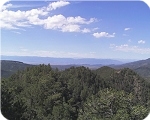 The last
upgrade on the line brought Ohio Brass "treated top" ugly mud... oh,
wait, all mud is ugly! Yes, contrary to what the mud daubers say or
what you may have heard or read I abhor "the mud"
Accessing the line requires hiking approximately three miles up a
canyon with a partially maintained trail with a gentle uphill grade.
The fun begins once you reach where the line crosses the trail. Your
options are to go either up or you can go up... that's right, you can
go up the line to the left or up the line to the right. The line pretty
much follows the mountainside straight up and straight down as it
crosses the ridge tops. Staying on the line right-of-way is fairly easy
as many poles are still standing. Many of the poles are the original
untreated trees cut in the area and have since been stubbed. The last
upgrade on the line brought Ohio Brass "treated top" ugly mud... oh,
wait, all mud is ugly! Yes, contrary to what the mud daubers say or
what you may have heard or read I abhor "the mud"
Accessing the line requires hiking approximately three miles up a
canyon with a partially maintained trail with a gentle uphill grade.
The fun begins once you reach where the line crosses the trail. Your
options are to go either up or you can go up... that's right, you can
go up the line to the left or up the line to the right. The line pretty
much follows the mountainside straight up and straight down as it
crosses the ridge tops. Staying on the line right-of-way is fairly easy
as many poles are still standing. Many of the poles are the original
untreated trees cut in the area and have since been stubbed.
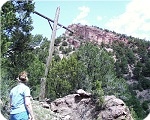 I have to admire the kind of person and the
work it took to construct this line through such a rugged area. Hiking
the line was bad enough in the summer I can just imagine what it must
have been like to have to maintain it during the harsh mountain winters
in the snow. As you hike along the line the ground is littered with the
carcasses of broken Locke 25s and the occasional "ugly mud". When it
was discovered that the insulator was prone to failure from lightening
strikes the line was upgraded and the 25s were left on the ground. The
weather did its damage causing the insulators to shatter from water
freezing. The 25s were assembled on site using Portland cement to
cement the top to the base and then cementing the base on the fluted
pin, which probably sealed the fate of most of the Locke 25s. Very few
mint specimens are known to exist today hence the good price realized
for a mint one. I have to admire the kind of person and the
work it took to construct this line through such a rugged area. Hiking
the line was bad enough in the summer I can just imagine what it must
have been like to have to maintain it during the harsh mountain winters
in the snow. As you hike along the line the ground is littered with the
carcasses of broken Locke 25s and the occasional "ugly mud". When it
was discovered that the insulator was prone to failure from lightening
strikes the line was upgraded and the 25s were left on the ground. The
weather did its damage causing the insulators to shatter from water
freezing. The 25s were assembled on site using Portland cement to
cement the top to the base and then cementing the base on the fluted
pin, which probably sealed the fate of most of the Locke 25s. Very few
mint specimens are known to exist today hence the good price realized
for a mint one.
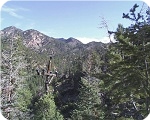 Many
exist in collections as kitsulators where an attempt is made to gather
all the pieces in order to glue one back together. This is the best
method for acquiring one for the collection. It is reported that a few
in very good condition were hauled out by collectors and non-collectors
in the early 60's. The chances of a finding a whole one still on the
line are very remote indeed. This is my third try at hunting this line
to be able to find enough pieces to reconstruct a lock 25. Surprisingly
the most difficult part of reconstructing a Locke 25 is finding enough
pieces to reconstruct a base. Having cement on the inside and outside
of the base pretty much destroyed the tops of the base causing them to
shatter into hundreds of pieces. Joining me once again on this hunt is
my mother who is always eager for a good hike. While she hasn't gotten
bit by the insulator collecting bug she does lend herself to helping me
find new things for the collection and can be persuaded at times to
help pack out that heavy glass. Working our way along the line we come
to a pole where I previously was able to assemble most of the pieces
for a complete top. I was missing a few small pieces that I wanted to
find the next time I was here. As my mother swatted at the pesky flies
and searched the area for things of interest I proceeded to
strategically rake the area for shards to the top. After thoroughly
combing the area I was able to find a few more pieces to Many
exist in collections as kitsulators where an attempt is made to gather
all the pieces in order to glue one back together. This is the best
method for acquiring one for the collection. It is reported that a few
in very good condition were hauled out by collectors and non-collectors
in the early 60's. The chances of a finding a whole one still on the
line are very remote indeed. This is my third try at hunting this line
to be able to find enough pieces to reconstruct a lock 25. Surprisingly
the most difficult part of reconstructing a Locke 25 is finding enough
pieces to reconstruct a base. Having cement on the inside and outside
of the base pretty much destroyed the tops of the base causing them to
shatter into hundreds of pieces. Joining me once again on this hunt is
my mother who is always eager for a good hike. While she hasn't gotten
bit by the insulator collecting bug she does lend herself to helping me
find new things for the collection and can be persuaded at times to
help pack out that heavy glass. Working our way along the line we come
to a pole where I previously was able to assemble most of the pieces
for a complete top. I was missing a few small pieces that I wanted to
find the next time I was here. As my mother swatted at the pesky flies
and searched the area for things of interest I proceeded to
strategically rake the area for shards to the top. After thoroughly
combing the area I was able to find a few more pieces to
 complete the top. While working, my mother
noticed a chunk of glass under the base of the stubbed pole. Further
inspection revealed an aqua CD 162 N.E.G.M.Co. which unfortunately was
cracked. Continuing on down the line we found no more prospective
kitsulators and reached the bottom of the canyon with a little stream
running down and a few shade trees providing relief from the blazing
sun. Preceding up the other side the remnants of some very large
multi-part "ugly mud" was littered down the mountainside. This area was
so steep the chances of finding all the pieces to anything were very
slight. Laboring along we discovered the faint remains of a maintenance
trail for the line that made the assent much easier. Reaching the top
presents you with quite a view of the line on its trek across the
ridges. We decide to see how far we can follow the line and hunt on the
way back. complete the top. While working, my mother
noticed a chunk of glass under the base of the stubbed pole. Further
inspection revealed an aqua CD 162 N.E.G.M.Co. which unfortunately was
cracked. Continuing on down the line we found no more prospective
kitsulators and reached the bottom of the canyon with a little stream
running down and a few shade trees providing relief from the blazing
sun. Preceding up the other side the remnants of some very large
multi-part "ugly mud" was littered down the mountainside. This area was
so steep the chances of finding all the pieces to anything were very
slight. Laboring along we discovered the faint remains of a maintenance
trail for the line that made the assent much easier. Reaching the top
presents you with quite a view of the line on its trek across the
ridges. We decide to see how far we can follow the line and hunt on the
way back.
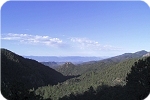 By mid
afternoon the heat and the fact we were running low on water along with
the increasingly thick brush and steep, loose rocky slope persuaded us
to start heading back. On the way back I start intensifying my search
for a prospective kitsulator. I find one spot where it looks like I
could put together a pretty good top. The pieces are cleanly broken and
in large chunks. I start assembling them and discover I'm still missing
about half the skirt. I search the area and 50 feet away I find another
large part of the skirt. By now I have a very good candidate and only
need that last part of the skirt and I'll have the best kitsulator I've
found to date. I really start hunting the area making bigger and bigger
circles around the whole area. After spending a half hour or more with
no luck I spy what looks like a chunk of skirt sticking out of the
duff. I reach down to pick it up only to find that it won't budge.
That's odd I thought, that piece isn't that big to be stuck in the
ground like that. I get my hand rake and proceed to start digging the
duff and dirt away. As I dig the piece keeps getting bigger and bigger
finally revealing the half section of a top to another insulator that
still won't budge. By mid
afternoon the heat and the fact we were running low on water along with
the increasingly thick brush and steep, loose rocky slope persuaded us
to start heading back. On the way back I start intensifying my search
for a prospective kitsulator. I find one spot where it looks like I
could put together a pretty good top. The pieces are cleanly broken and
in large chunks. I start assembling them and discover I'm still missing
about half the skirt. I search the area and 50 feet away I find another
large part of the skirt. By now I have a very good candidate and only
need that last part of the skirt and I'll have the best kitsulator I've
found to date. I really start hunting the area making bigger and bigger
circles around the whole area. After spending a half hour or more with
no luck I spy what looks like a chunk of skirt sticking out of the
duff. I reach down to pick it up only to find that it won't budge.
That's odd I thought, that piece isn't that big to be stuck in the
ground like that. I get my hand rake and proceed to start digging the
duff and dirt away. As I dig the piece keeps getting bigger and bigger
finally revealing the half section of a top to another insulator that
still won't budge.
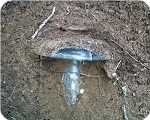 I call
my mother over and explain I think I have found a complete Locke 25!
She reminds me to take some pictures of the find before I finish
unearthing it. I continue digging to reveal a base with pin. Of course
nature had been at work so the base and top were cracked but a complete
unit was salvageable. Funny
thing I should have been elated at the find but I was still
disappointed at not finding that other section of skirt I had spent so
much time looking for. I carefully remove the insulator piece by piece
and carefully wrap the pieces in bubble wrap for the long hike back to
our camping spot. Starting out that morning hiking over the mountains
with a light pack didn't seem so bad but loaded and tired the long trip
back seemed agonizingly slow. I call
my mother over and explain I think I have found a complete Locke 25!
She reminds me to take some pictures of the find before I finish
unearthing it. I continue digging to reveal a base with pin. Of course
nature had been at work so the base and top were cracked but a complete
unit was salvageable. Funny
thing I should have been elated at the find but I was still
disappointed at not finding that other section of skirt I had spent so
much time looking for. I carefully remove the insulator piece by piece
and carefully wrap the pieces in bubble wrap for the long hike back to
our camping spot. Starting out that morning hiking over the mountains
with a light pack didn't seem so bad but loaded and tired the long trip
back seemed agonizingly slow.
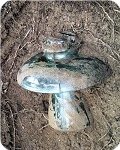 Coupled with the heat and the water gone
the death march began with only three ridges left to cross! I somehow
find the energy to search one more spot on the way back where I
assemble a mostly complete top with just a few pieces missing. Why does
it always happen that way? The heat
and my thirst drive me to continue on. I'll have to come back tomorrow
for that one. Reaching camp we rest for a while and the decision is
made to pack our finds for the day back out adding another few miles to
the many miles we had already hiked that day. As we leave the vehicle
with emptied packs it's starting to get dark. Thankfully we had
flashlights to light our way along the trail. Coupled with the heat and the water gone
the death march began with only three ridges left to cross! I somehow
find the energy to search one more spot on the way back where I
assemble a mostly complete top with just a few pieces missing. Why does
it always happen that way? The heat
and my thirst drive me to continue on. I'll have to come back tomorrow
for that one. Reaching camp we rest for a while and the decision is
made to pack our finds for the day back out adding another few miles to
the many miles we had already hiked that day. As we leave the vehicle
with emptied packs it's starting to get dark. Thankfully we had
flashlights to light our way along the trail.
 Along with Locke 25s this
area offers bears, cougars, and rattlesnakes. Meeting one on a dark
trail was not my idea of a good time! All of a sudden up in front my
mother lets out a yell that scares my heart out of its cage! There next
to the trail is a black mass with two glowing eyes! Relief comes
quickly as we discover a rock containing some type of reflective
mineral in the perfect spots for eyes. The rest of the way back to camp
I catch myself looking over my shoulder searching for that rock that
might be watching me. I crawl into my tent and fall asleep almost
immediately only to waken a short time later, it seems, at the crack of
dawn to get an early start while the weather is still cool. We head
directly for the spot where I had started assembling the top with the
couple small pieces missing. I reach it and start the laborious process
of sifting through the duff and dirt while my mother goes off
exploring. I finally call it quits when she returns to pack up what I
have. She reports that there might be a salvageable base at the next
pole site. I start scratching around and start digging parts of a top
out of the brush. This one looks pretty complete with all the pieces
accounted for. With Along with Locke 25s this
area offers bears, cougars, and rattlesnakes. Meeting one on a dark
trail was not my idea of a good time! All of a sudden up in front my
mother lets out a yell that scares my heart out of its cage! There next
to the trail is a black mass with two glowing eyes! Relief comes
quickly as we discover a rock containing some type of reflective
mineral in the perfect spots for eyes. The rest of the way back to camp
I catch myself looking over my shoulder searching for that rock that
might be watching me. I crawl into my tent and fall asleep almost
immediately only to waken a short time later, it seems, at the crack of
dawn to get an early start while the weather is still cool. We head
directly for the spot where I had started assembling the top with the
couple small pieces missing. I reach it and start the laborious process
of sifting through the duff and dirt while my mother goes off
exploring. I finally call it quits when she returns to pack up what I
have. She reports that there might be a salvageable base at the next
pole site. I start scratching around and start digging parts of a top
out of the brush. This one looks pretty complete with all the pieces
accounted for. With
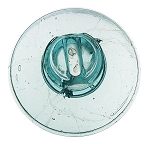 unembossed!
Until this time an unembossed top has not been reported. The mystery is why these were made before the mold engraving was done? I plan
to return to the site and packs loaded I decide that's enough for the day and
proceed on another mountain death march back to camp.
If you recall at the beginning of this article, I mentioned an
exception to the embossing on the Locke 25s. I discovered after I got
back home a week later while unpacking my finds and starting the
assembly process that the last top I found was completely discover if the base was the regular embossed
unit or one of the unembossed units similar to the ones used with that
abomination M#2795 marrying mud to glass. Sacrilegious! The desecration
of good glass tainted by mud! Oh, excuse me, where were we?
Oh yes, it's out there waiting to be discovered and if you would like
to experience the death march just give me a call and it can be
arranged! unembossed!
Until this time an unembossed top has not been reported. The mystery is why these were made before the mold engraving was done? I plan
to return to the site and packs loaded I decide that's enough for the day and
proceed on another mountain death march back to camp.
If you recall at the beginning of this article, I mentioned an
exception to the embossing on the Locke 25s. I discovered after I got
back home a week later while unpacking my finds and starting the
assembly process that the last top I found was completely discover if the base was the regular embossed
unit or one of the unembossed units similar to the ones used with that
abomination M#2795 marrying mud to glass. Sacrilegious! The desecration
of good glass tainted by mud! Oh, excuse me, where were we?
Oh yes, it's out there waiting to be discovered and if you would like
to experience the death march just give me a call and it can be
arranged!
|
|
|
